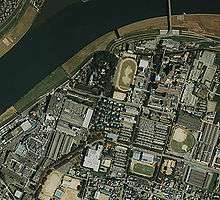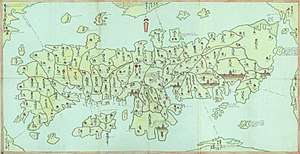Kurume Domain
Kurume Domain (久留米藩, Kurume-han) was a Japanese domain of the Edo period. It was associated with Chikugo Province in modern-day Fukuoka Prefecture on the island of Kyushu.
Remains of Kurume Castle (November 4, 2010)

The site of Kurume Castle, as seen from the air
In the han system, Kurume was a political and economic abstraction based on periodic cadastral surveys and projected agricultural yields.[1] In other words, the domain was defined in terms of kokudaka, not land area.[2] This was different from the feudalism of the West.
List of daimyōs
The hereditary daimyōs were head of the clan and head of the domain. At Kurume, the Tokugawa shōguns granted 210,000 koku to the Arima clan from 1620 to 1868.[3]
![]()
- Arima Toyouji (有馬豊氏), 1620–1642[4]
- Arima Tadayori (有馬忠頼), 1642–1655
- Arima Yoritoshi (有馬頼利), 1655–1668
- Arima Yorimoto (有馬頼元), 1668–1705
- Arima Yorimune (有馬頼旨), 1705–1706
- Arima Norifusa (有馬則維), 1706–1729
- Arima Yoriyuki (有馬頼徸), 1729–1783[4]
- Arima Yoritaka (有馬頼貴), 1784–1812
- Arima Yorinori (有馬頼徳), 1812–1844
- Arima Yoritō (有馬頼永), 1844–1846
- Arima Yorishige (有馬頼咸), 1846–1871
The Arima clan leaders became viscounts in the Meiji period.
Genealogy (simplified)
- Arima Noriyori, Lord of Sanda (1533–1602)





- A daughter, who m. Ishino (Akamatsu) Ujimitsu (1553–1606)
- Akamatsu
- Ishino
- Ishino
- Ishino Norikazu



- Yorinao (1779-1805)



- Yoritsumu, 1st Count (1864–1927; Count: 1884)
- Yoriyasu, 2nd Count (1884–1957; Count: 1927–1947)
- Yorichika (1918–1980)
- Yorinaka (b. 1959)
- Yorichika (1918–1980)
- Yoriyasu, 2nd Count (1884–1957; Count: 1927–1947)
- Yoritsumu, 1st Count (1864–1927; Count: 1884)
- Yorinao (1779-1805)
- Ishino Norikazu
- Ishino
- Ishino
- Akamatsu
See also
- List of Han
- Abolition of the han system
References

- Mass, Jeffrey P. and William B. Hauser. (1987). The Bakufu in Japanese History, p. 150.
- Elison, George and Bardwell L. Smith (1987). Warlords, Artists, & Commoners: Japan in the Sixteenth Century, p. 18.
- Papinot, Jacques Edmond Joseph. (1906). Dictionnaire d’histoire et de géographie du Japon; Papinot, (2003). "Arima" at Nobiliare du Japon, pp. 2–3; retrieved 2013-4-4.
- Nussbaum, Louis-Frédéric. (2005). "Arima Toyouji" in Japan Encyclopedia, p. 45.
- Genealogy (jp)
External links
- "Kurume" at Edo 300 (in Japanese)
This article is issued from Wikipedia. The text is licensed under Creative Commons - Attribution - Sharealike. Additional terms may apply for the media files.